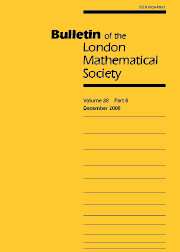No CrossRef data available.
Article contents
BASIL CAMERON RENNIE
Published online by Cambridge University Press: 01 November 1999
Abstract
Basil Rennie was born in London on 24 December 1920. He came from a long line of engineers, a family tradition that surfaced in much of his later mathematical work. He attended the University College School in London, where he obtained a Mathematical Scholarship at Peterhouse, Cambridge. After graduating in 1941, he found employment first with the Rolls Royce Aero Engine division, then with Austin Motor Works. In 1943 he joined the Fleet Air Arm of the Royal Navy as a radio mechanic, and he served in the Pacific Fleet until the end of the war. This was his first contact with Australia, and he seems to have liked what he saw.
After his service with the Navy, Rennie resumed his studies at Peterhouse and received a PhD in 1949. Given his strong practical bent, it is perhaps surprising that he chose lattice theory as the subject of his thesis; apart from an article [1] in the Proceedings of the London Mathematical Society (he became a member in 1947) and a small booklet [2] published at his own expense, he never touched lattice theory again. It was at Peterhouse that he took up rowing, an activity which became a life-long interest.
In 1950 Rennie accepted an offer of a senior lectureship at the University of Adelaide in South Australia. This was a time of considerable post-war expansion at the University, and its forward-looking Vice-Chancellor A. P. Rowe recruited a number of young and promising staff from overseas, some to leading positions. For instance, he established a Mathematical Physics department (unique in Australia) with the 30-year-old H. S. Green as its head, which became one of the most active research departments in Australia.
- Type
- OBITUARY
- Information
- Copyright
- © The London Mathematical Society 1999


